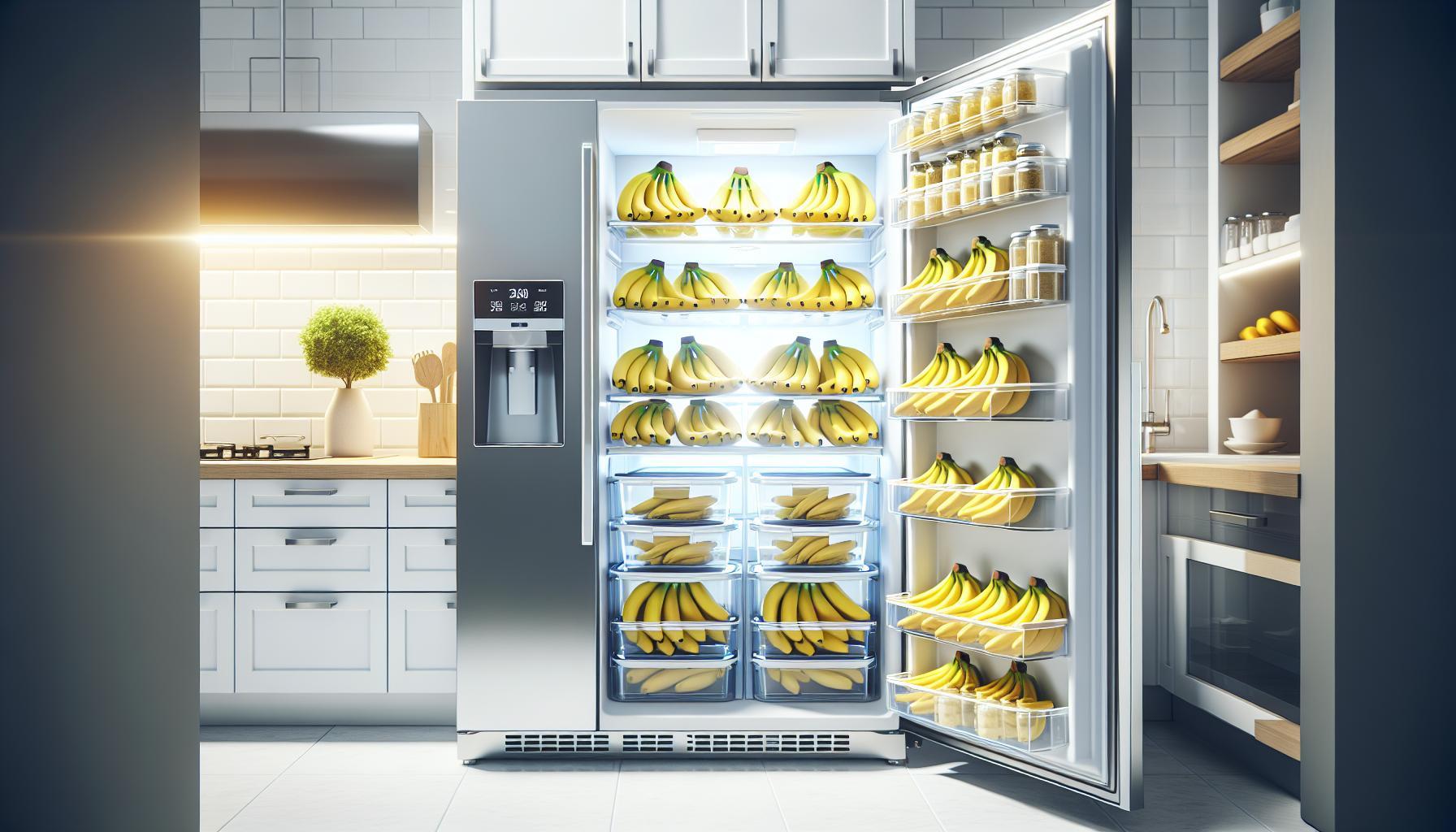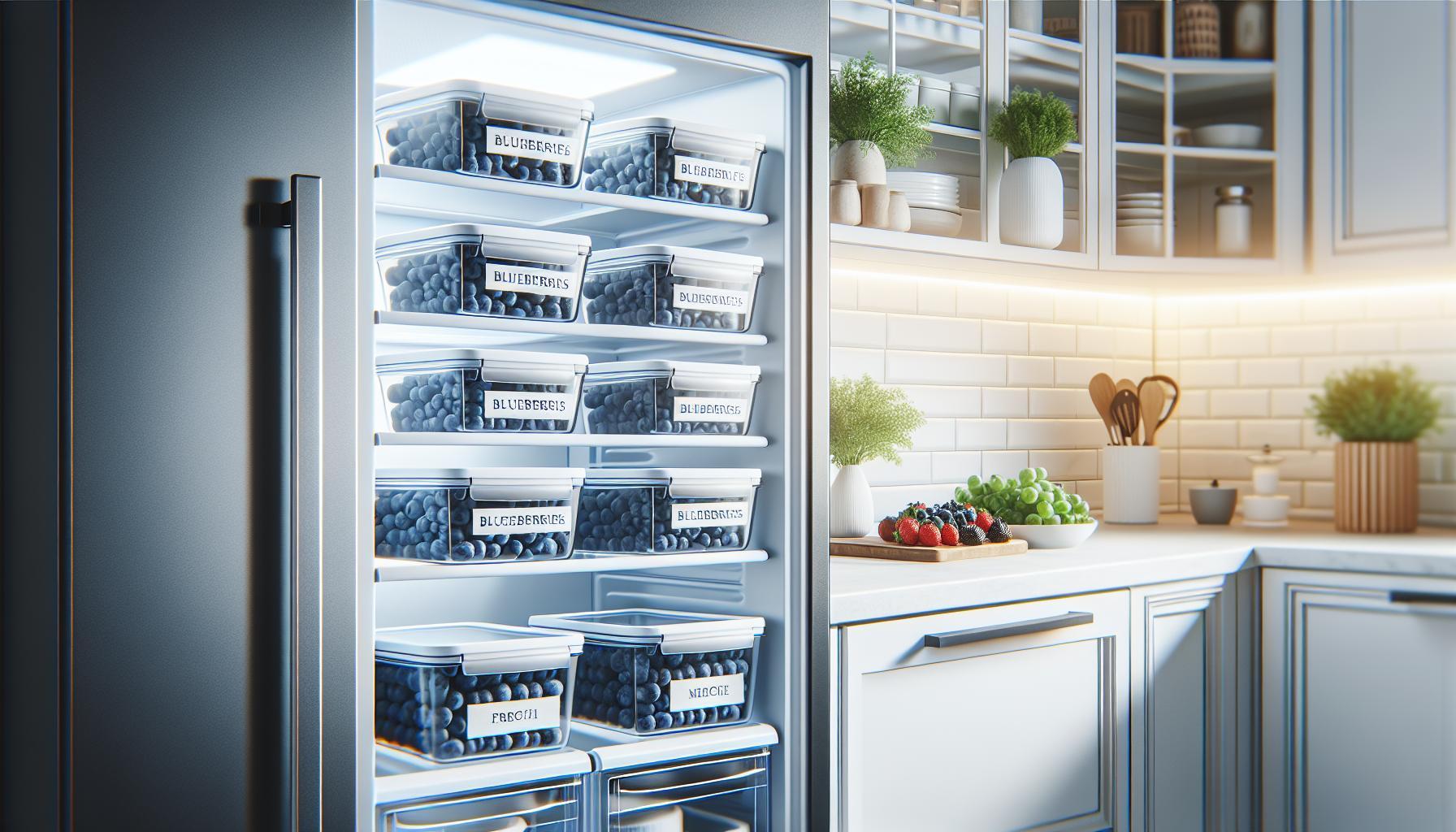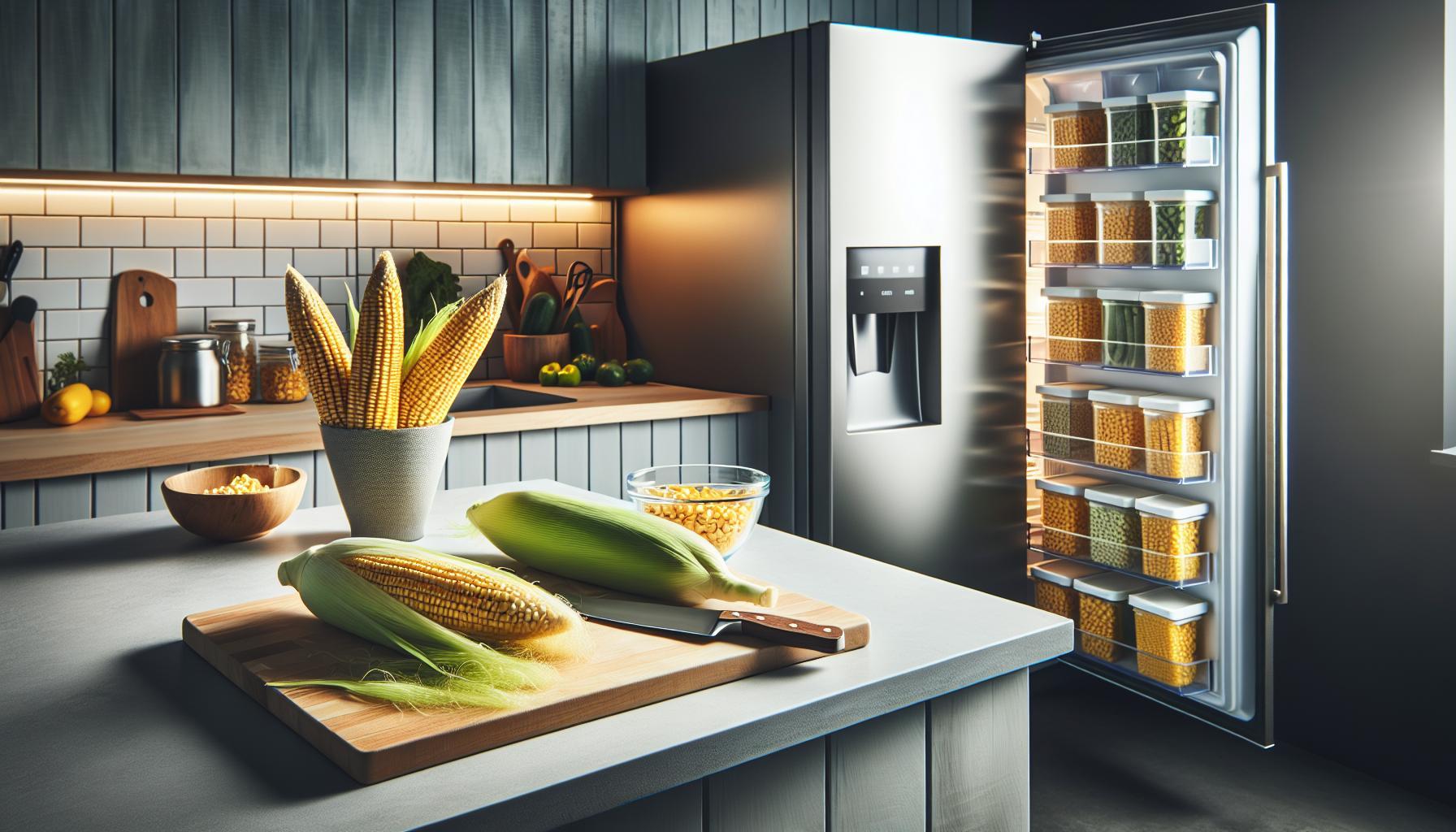Did you know that storing bananas in the fridge can actually prolong their freshness and prevent premature browning? While these nutrient-packed fruits are beloved for their convenience and health benefits, knowing how to store them correctly can make all the difference between a delicious snack and an unsightly brown mush.
Understanding how long bananas last in the fridge and implementing simple storage techniques not only helps minimize food waste but also keeps your bananas ready for smoothies, snacks, or baking when you need them. In this guide, we’ll explore the ideal storage practices to extend the life of your bananas and maintain their appealing yellow hue, ensuring you get the most out of every bunch. Continue reading to discover practical tips and science-backed techniques that will help you enjoy your bananas at their best!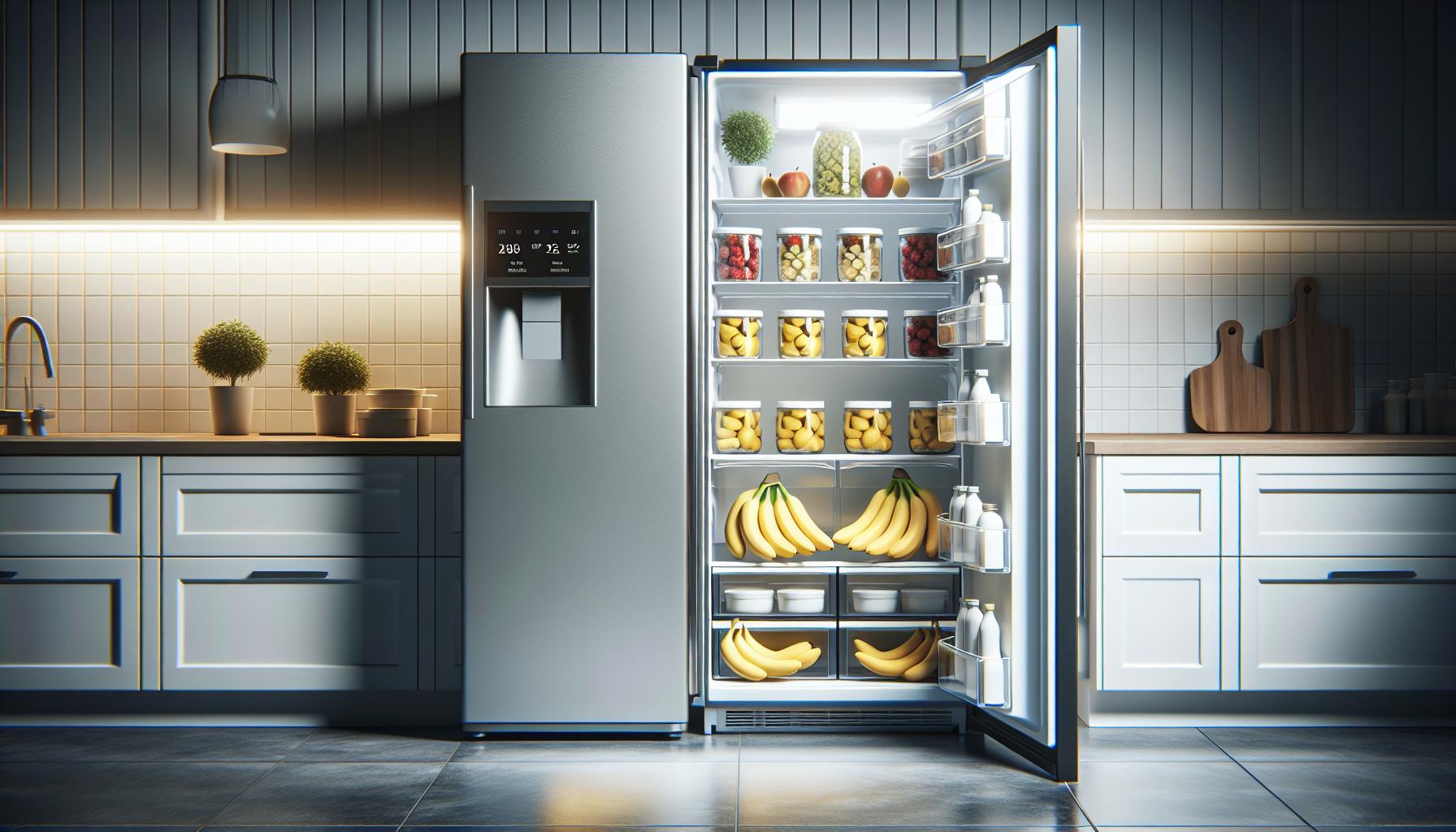
How Long Do Bananas Last When Stored in the Fridge?
Bananas can last significantly longer when stored in the fridge compared to leaving them at room temperature, which can help you enjoy their nutritional benefits without waste. Typically, when placed in the refrigerator, bananas will remain fresh for about 5 to 7 days, depending on their ripeness before storage. While it’s common for the skins to darken in the fridge, the fruit itself tends to stay firm and is still perfectly good to eat, maintaining its flavor and texture.
When storing bananas in the fridge, place them in the fruit and vegetable drawer to provide a balanced temperature and humidity. It’s essential to keep them away from other fruits, particularly ethylene-producing ones like apples and avocados, which can accelerate ripening. If you notice that bananas are starting to brown more quickly than expected even in the fridge, it can be beneficial to separate them from other fruits, as this may extend their fresh lifespan.
Observing how bananas respond in the fridge can also provide insight into their ripening process. If you prefer your bananas less ripe, refrigerating them soon after they reach your desired ripeness can slow down the browning of the peel and preserve their flavor. Storing green bananas in the fridge, however, is not recommended as it can inhibit their natural ripening process, resulting in a less sweet taste upon ripening. Thus, it is crucial to keep an eye on their stages and store them accordingly for optimal taste and texture.
Understanding the Ideal Banana Storage Temperature
Storing bananas at the right temperature is key to maximizing their shelf life and maintaining their quality. Bananas thrive in warm environments, typically between 12°C and 15°C (54°F and 59°F), which is why they are best stored outside the refrigerator when at a perfect ripeness. However, once bananas reach your desired ripeness, moving them to the fridge can help prolong their freshness, keeping them good for an additional 5 to 7 days. This is particularly effective for bananas that are just a touch overripe or for those that you want to preserve before they spoil.
When bananas are placed in the fridge, their skins will likely darken due to the cold, but it’s important to note that this does not mean the fruit itself has gone bad. The cold temperature slows down the production of ethylene gas, which is a natural plant hormone that prompts ripening. This means that while the exterior may appear unattractive, the interior remains firm and delicious, allowing you to enjoy your bananas without waste. To optimize their storage, always keep them in the crisper drawer of your refrigerator, as this compartment provides a slightly higher humidity level, which helps further reduce moisture loss.
Understanding how bananas interact with other fruits is essential in maintaining their quality. Keeping bananas away from ethylene-sensitive fruits, such as apples and pears, can help prevent premature ripening. If you plan to buy green bananas, it’s best to leave them at room temperature to allow them to ripen naturally until they reach your preferred sweetness, after which they can be transferred to the fridge. On the other hand, if they’re already ripe and you want to prolong their edibility, transferring them to the fridge will help keep them from becoming overripe too quickly.
By mastering the nuances of banana storage temperature, you can ensure that you always have these nutritious fruits on hand without the risk of them turning brown and mushy before you’re ready to enjoy them.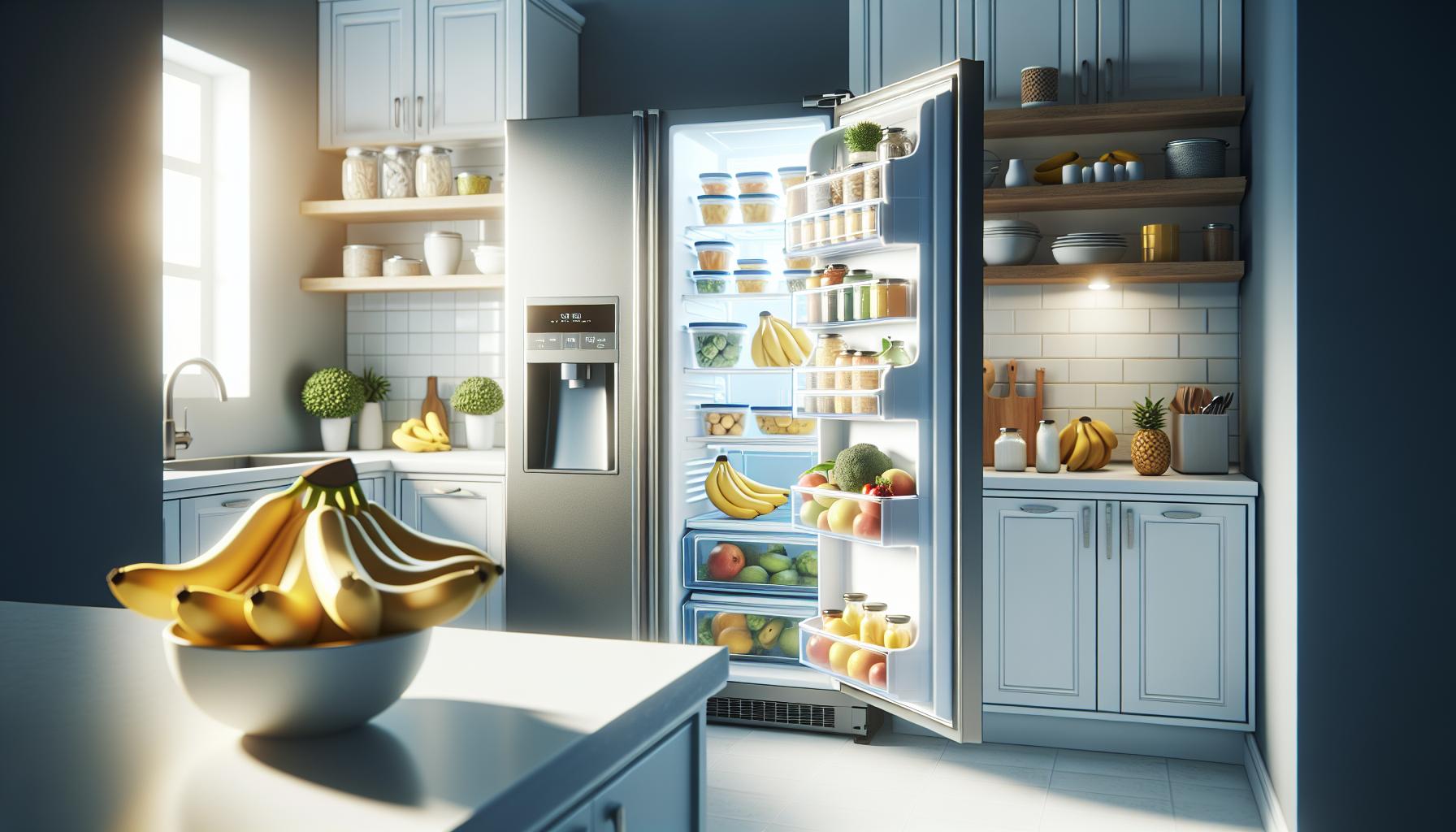
Do Bananas Ripen Faster in the Fridge?
Placing bananas in the refrigerator can significantly influence their ripening process, often leading to confusion among consumers. Contrary to common belief, bananas do not ripen faster in the fridge; in fact, they ripen much more slowly due to the cold temperature. When bananas are stored at cooler temperatures, the production of ethylene gas, a natural plant hormone that regulates ripening, is significantly reduced. This means that while the skins may darken when placed in the refrigerator, the fruit inside remains fresh and palatable for a longer time.
When bananas reach your desired ripeness, a swift transfer to the fridge can help prolong their edible life. In the refrigerator, bananas can last an additional 5 to 7 days, depending on their initial ripeness. This is particularly effective for bananas that are just past their prime but not yet overripe. However, if you leave them in warm environments, they will continue to ripen quickly, potentially leading to overripe fruit within a few days.
To optimize storage, keep your bananas in the crisper drawer of the refrigerator. This designated area maintains slightly higher humidity levels, which can help preserve the moisture of the bananas while also protecting them from the cold air that can lead to drying out. Proper storage not only maximizes their shelf life but also enhances your enjoyment of these nutritious fruits by keeping the interiors firm and flavorful even as the skins darken.
In summary, to manage banana ripening effectively, consider your timing and environment. If you prefer your bananas at a specific level of ripeness, monitor them closely, and make the transition to the refrigerator at the right moment to prevent waste and enjoy them longer.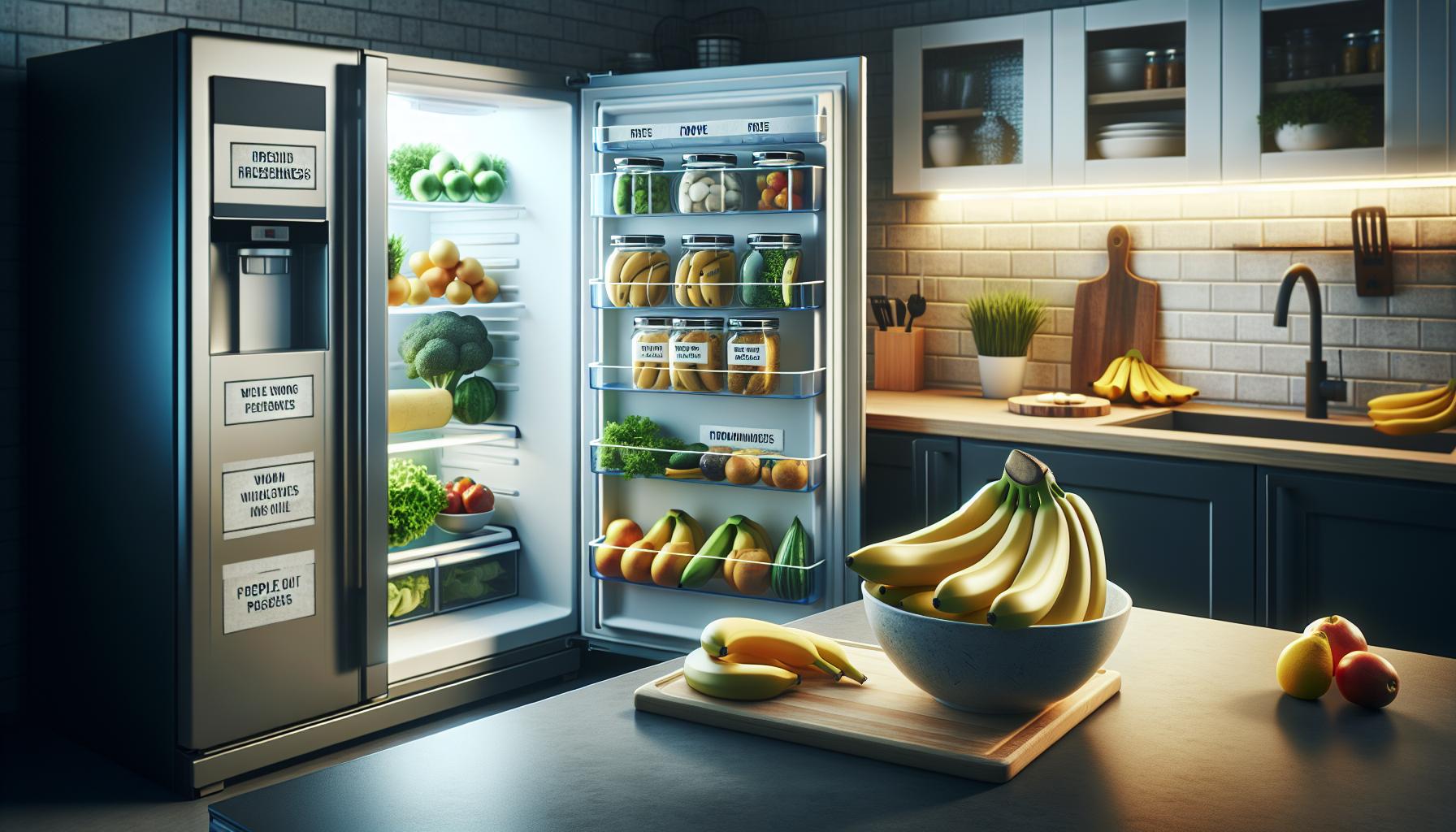
The Science Behind Banana Browning
The fascinating process of banana browning is primarily linked to enzymatic reactions, particularly involving an enzyme called polyphenol oxidase (PPO). This enzyme interacts with phenolic compounds in bananas and, in the presence of oxygen, triggers a series of chemical reactions that lead to browning. The result is the darkening of the skin and, sometimes, the flesh of the banana. Although this change in color can suggest spoilage, it often does not indicate that the fruit is unsafe to eat.
When bananas are stored in the refrigerator, the low temperatures slow down these enzymatic reactions significantly. While the skins may turn brown in the cold, the fruit inside can remain fresh for a longer period than if left at room temperature. This is why even after the exterior has darkened, the banana can still be perfectly good for consumption. The temperature where bananas stay under 56°F (approximately 13°C) hampers the ripening process by reducing the production of ethylene gas, a natural hormone that accelerates ripening and browning.
To mitigate browning and maintain the appealing quality of bananas in a refrigerator, some practical steps can be taken. Storing bananas unpeeled is always best, as the peel provides a protective barrier against moisture loss and spoilage. If you have overripe bananas, quick usage in smoothies, baked goods, or even freezing for later use can be ideal strategies to prevent waste.
Understanding this science promotes better storage practices. With the right methods, you can enjoy bananas at their best quality, extending their shelf life while minimizing unnecessary waste. So, next time you see browning skin, remember that it doesn’t necessarily signal decline; rather, it highlights the fruit’s transformation, one that can still be delicious and nutritious when prepared thoughtfully.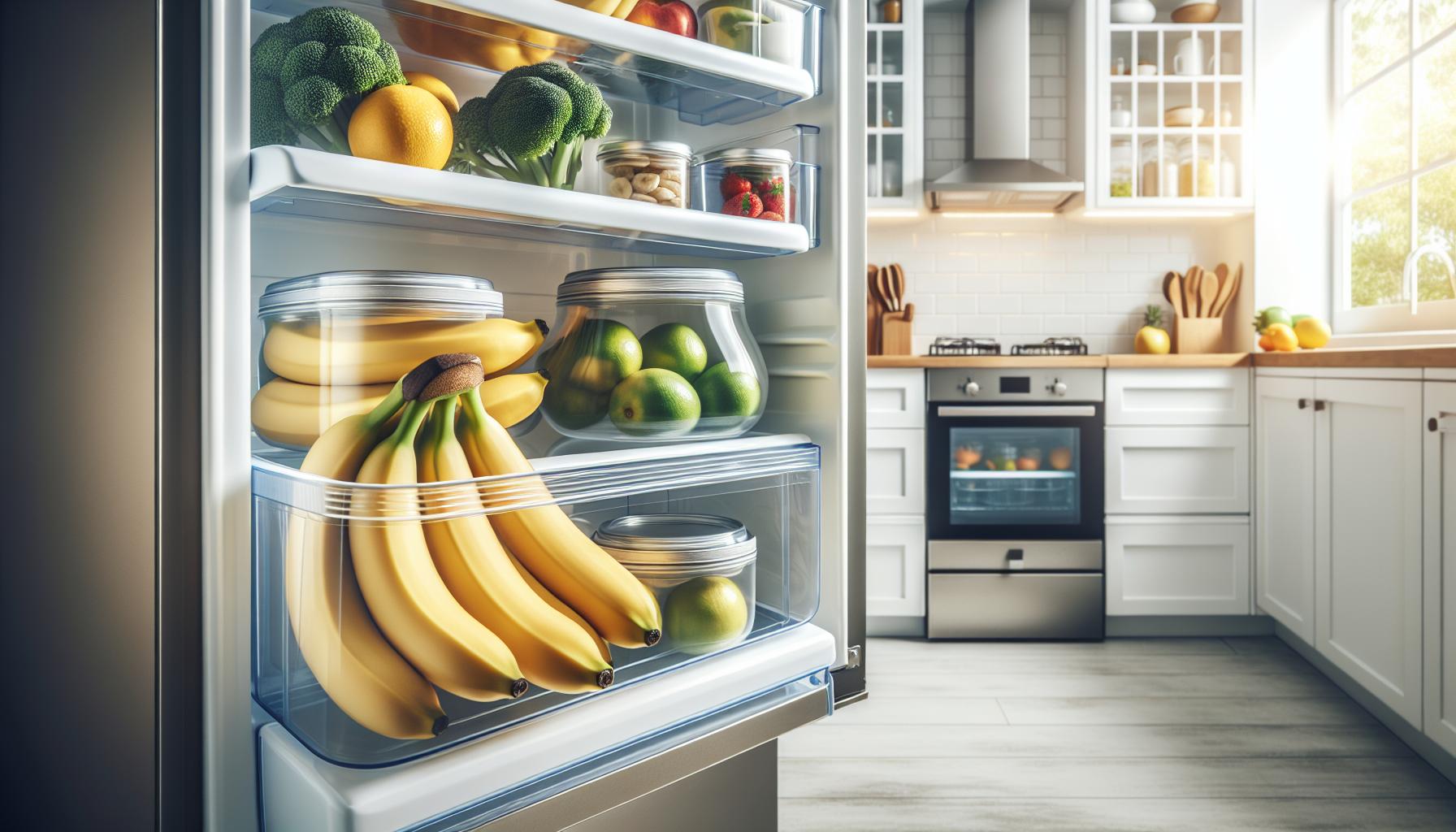
Best Practices for Storing Bananas in the Fridge
To keep bananas fresh longer in the refrigerator, it’s essential to follow some effective best practices. Storing bananas at cold temperatures can lead to browning of the skin due to enzyme activity, but by using specific techniques, you can extend their shelf life while minimizing moisture loss and spoilage risks.
One of the most important strategies is to store bananas unpeeled. The peel serves as a natural barrier, protecting the fruit from moisture loss and external contaminants. If you need to store cut or peeled bananas, it’s best to wrap them tightly in plastic wrap or place them in an airtight container to limit exposure to air, which can accelerate browning.
Additionally, consider separating bananas from other fruits when storing them in the fridge. Other fruits typically produce ethylene gas, which can speed up the ripening process of bananas. For the best results, store bananas in the designated fruit drawer of your refrigerator, ideally at a temperature between 47°F to 50°F (8°C to 10°C). Make sure they are placed away from the walls of the refrigerator where cold air might cause chilling injury.
If you find that a bunch ripens too quickly despite your best efforts, quickly utilizing overripe bananas can also be a practical solution. Overripe bananas can be mashed and incorporated into smoothies, banana bread, or frozen for later use. This proactive approach ensures that they don’t go to waste while also providing delicious options for use in various recipes.
By following these practices, you allow bananas to reach their full potential while minimizing food waste and maximizing culinary enjoyment. Remember that while browning can be disheartening to look at, it often doesn’t affect the fruit’s taste or safety-it’s an indication of the banana’s transformation rather than a signal of spoilage.
Tips to Prevent Premature Browning in Bananas
To ensure that bananas retain their bright yellow color and delicious flavor for as long as possible, it’s crucial to adopt a few proactive strategies to combat premature browning. Understanding that bananas are sensitive to both temperature and ethylene gas helps in implementing these practical solutions effectively. When bananas are exposed to cold temperatures, the chilly environment can activate enzymes that hasten the browning process. Hence, proper storage becomes a key factor.
One effective approach to prevent premature browning is to store bananas unpeeled and at the right temperature. The natural peel acts as a protective barrier against moisture loss and spoilage agents. If you need to store cut or mashed bananas, it is best to wrap them tightly in plastic wrap or place them in an airtight container. This minimizes their exposure to air, which is a major contributor to oxidation and browning. Additionally, keeping bananas separate from other fruits is vital, as many fruits release ethylene gas that accelerates ripening. For optimal results, designate a specific area in your refrigerator’s fruit drawer, aiming to keep bananas at temperatures between 47°F to 50°F (8°C to 10°C).
Another simple yet effective tip is to apply an acid or a natural enzyme blocker to the cut surfaces of bananas. For instance, a light coating of lemon juice or an apple cider vinegar solution can significantly slow down the enzymatic reactions that lead to browning. If a bunch of bananas ripens too quickly, consider using overripe bananas creatively to avoid waste. They can be made into smoothies, baked goods like banana bread, or frozen for later use. This not only ensures minimized spoilage but also allows for tasty recipes that feature your ripe bananas. By following these best practices, you can keep your bananas fresher for a longer duration, enhancing both their visual appeal and flavor during your culinary adventures.
How to Tell If a Banana is Still Good to Eat
To determine if a banana is still good to eat, look beyond just its color. While a few brown spots on the peel are typical as bananas ripen, they do not necessarily indicate spoilage. Instead, focus on several sensory clues. First, check the firmness; a ripe banana should yield slightly to gentle pressure. If it feels excessively mushy or has any significant soft spots, it may no longer be at its best.
Next, inspect the peel. A banana with a uniformly brown or black peel often indicates over-ripeness, but it may still be good to eat in smoothies or baked goods. Smell the banana-if it emits a strong, sour odor, it’s best to discard it. Additionally, look for any signs of mold or unusual discoloration on the peel or fruit itself, which can suggest spoilage.
For optimal quality, bananas that have started to brown should ideally be consumed soon. If properly stored in the fridge, they can last about a week from the time they reach peak ripeness, but consumption should be based on the aforementioned sensory checks. For bananas that have become overripe, consider alternative uses: they are perfect for banana bread, pancakes, or smoothies, allowing you to minimize waste while enjoying their natural sweetness.
Creative Ways to Use Overripe Bananas
Overripe bananas are not just a sign of impending spoilage; they are also a treasure trove of culinary possibilities. These sweet, soft fruits can be transformed into an array of delicious dishes, allowing you to reduce waste while enjoying their rich flavor. Here are some inventive ways to make the most of your overripe bananas.
One of the most popular uses for overripe bananas is in baking, particularly for banana bread. Their natural sweetness and moistness enhance the texture of baked goods. To make a simple banana bread, mash 2-3 overripe bananas and mix them with flour, sugar, eggs, and baking soda. Bake at 350°F (175°C) for about an hour until golden brown. This classic treat is perfect for breakfast or as a snack.
Bananas can also shine in breakfast recipes. Consider whipping up a batch of banana pancakes. Combine mashed bananas with flour, eggs, and your choice of milk to create a fluffy batter. Cook them on a hot griddle, and you’ll have a satisfying start to your day. For a twist, add chocolate chips or nuts for added flavor and texture.
Smoothies are another excellent avenue for utilizing overripe bananas. Blend them with yogurt, milk, or a dairy-free alternative, along with other fruits and greens for a nutritious drink. The banana not only sweetens the smoothie but also gives it a creamy consistency. You can freeze overripe bananas beforehand to create an ice-cold, thick smoothie without the need for extra ice.
Lastly, overripe bananas make a perfect ingredient for desserts. Consider making banana muffins, banana pudding, or even a banana cream pie. They can also be frozen and later used as popsicles-simply blend the bananas with some milk and pour the mixture into popsicle molds. Once frozen, these treats are healthy and refreshing.
Embracing overripe bananas in your cooking not only reduces food waste but adds versatility to your meals. With these creative ideas, you can enjoy the sweet taste of bananas long after their peel has browned.
The Impact of Ethylene Gas on Bananas
The ripening of bananas is significantly influenced by ethylene gas, a natural plant hormone that plays a crucial role in the fruit’s development. Bananas release ethylene gas as they ripen, triggering a series of physiological changes. This process not only affects how long bananas last but also impacts how they should be stored, especially when considering refrigeration.
Storing bananas in the fridge helps slow down the ripening process, but it’s essential to understand the effects of ethylene gas in this context. When bananas are placed in the cold, their skins may darken due to the cold temperature, which causes the cellular structures in the skin to break down. However, the ethylene production continues, albeit at a reduced rate compared to room temperature. If stored correctly, bananas can last up to two weeks in the fridge. For optimal results, it’s advisable to separate them from other fruits that produce high amounts of ethylene, such as apples and avocados, as this can further influence ripening and potentially lead to premature browning.
To mitigate the impact of ethylene gas while maximizing freshness, consider the following storage tips:
- Use a ventilated bag: Storing bananas in a breathable bag can help reduce ethylene concentration around the fruit.
- Wrap the stems: Wrapping the stems of bananas with plastic wrap can minimize ethylene release to surrounding fruit.
- Refrigerate only when ripe: If you have ripe bananas, placing them in the fridge can extend their shelf life, but it’s best to do so after they have reached your desired ripeness.
Understanding ethylene gas’s role in the ripening process empowers consumers to store bananas effectively. By managing ethylene exposure, you can enjoy fresher bananas for longer, reducing waste and enhancing your culinary options.
Debunking Common Banana Storage Myths
Many people believe that storing bananas in the refrigerator will ruin them, but this notion requires some clarification. While it’s true that bananas can darken in the cold, refrigeration can actually prolong their freshness when applied correctly. Understanding the science behind banana storage fosters better decisions that reduce waste and enhance usability.
A prevalent myth is that all fruits should be kept at room temperature. However, bananas, once fully ripe, benefit from refrigeration. This technique slows down their ripening process significantly, keeping them good for an additional week or more. That’s because refrigeration halts the enzymatic processes that occur at room temperature, which means you can enjoy ripe bananas for longer. Just remember, it’s best to refrigerate them only after they have reached the desired ripeness.
Another common misconception is that storing bananas with other fruits will enhance their freshness. This is misleading, as many other fruits emit ethylene gas, which accelerates the ripening of bananas. For optimal storage, bananas should be kept separate from ethylene-producing fruits, such as apples and avocados, especially in enclosed spaces like fruit bowls. Using techniques like wrapping the stems or putting them in a ventilated bag can further manage ethylene gas exposure, helping to maintain banana longevity.
Lastly, some suggest that once bananas turn brown, they are no longer edible. In reality, brown bananas are often sweeter and perfectly suitable for baking or smoothies. Emphasizing these debunked myths informs better storage practices and encourages creative uses for overripe fruit, ultimately reducing food waste and making the most of your grocery purchases.
Storage Tips for Other Fruits to Avoid Browning
To prevent browning in fruits, particular attention must be given to the conditions in which they are stored. Browning, notably in fruits like apples, pears, bananas, and avocados, can be attributed to enzymatic reactions that occur when the fruit is cut or overripe. However, with mindful strategies, you can significantly extend their freshness and reduce waste.
One efficient method for slowing browning is to apply an acid to the surface of the fruit. This could be as simple as squeezing fresh lemon juice over cut apples or avocados. The citric acid acts as a barrier, slowing the oxidation process that causes browning. For an added layer of protection, you can also store cut fruits in an airtight container and sprinkle a little salt on them before sealing. This maintains moisture and limits exposure to air.
For tropical fruits like bananas and mangoes, consider storing them in a cool, dark place away from direct sunlight to minimize ethylene production. As these fruits ripen, they release ethylene gas, which can hasten the ripening and subsequent browning of nearby fruits. To extend shelf life, place them in a separate area or use perforated plastic bags to allow airflow while preventing excess ethylene exposure.
When it comes to berries, always wash them gently before storage and keep them dry. Moisture can promote mold growth and hasten spoilage. An excellent practice is to place them in a ventilated container lined with paper towels to absorb excess moisture, ensuring they remain fresh. Remember, the majority of fruits have a shelf life that varies, so it’s advisable to check them regularly and consume or process them before they become overripe.
Emergency Storage Solutions for Ripe Bananas
In situations where bananas are on the verge of over-ripening but you want to salvage their quality, quick action can provide effective solutions for ideal storage. Whether you’ve bought too many or simply can’t consume them fast enough, consider these emergency storage strategies to prolong their shelf life and keep browning at bay.
A highly effective method is to freeze ripe bananas. Simply peel them, place them in a freezer-safe bag or container, and store them in the freezer. They can last several months in this state without sacrificing flavor or texture, making them excellent for smoothies, baking, or other recipes later on. This not only prevents spoilage but also offers convenience when you need a quick ingredient. Additionally, if you prefer to keep them fresh, you can separate them from one another, using plastic wrap or paper towels between each banana to minimize bruising and slow down ripening.
Another practical solution involves storing ripe bananas in a cool, dry place away from other fruits that produce ethylene gas, which accelerates ripening. If separation isn’t possible, placing the bananas in a plastic bag with a few holes will allow for airflow while still protecting them from excess ethylene exposure. For those with limited space, consider hanging bananas from a hook or banana hanger, which helps to prevent bruising and allows air circulation around the fruit.
Finally, if your bananas are already starting to brown, don’t discard them! Overripe bananas can be repurposed in various ways, such as in banana bread or as a natural sweetener in smoothies and oatmeal. Remember to check on them regularly; any bananas that start to show significant signs of spoilage, like an off smell or an excessively mushy texture, should be used promptly or composted to maintain a safe food environment. Being proactive ensures you get the best flavor and extends the shelf life of your bananas effectively.
Faq
Q: How long can I keep bananas in the fridge before they spoil?
A: Bananas can last in the fridge for about 7 to 10 days. While their skin may turn brown, the fruit inside remains edible longer. To maximize freshness, store them in a ventilated bag or container [1[1].
Q: What is the best way to store bananas to prevent browning in the fridge?
A: To prevent browning, wrap the stems of bananas with plastic wrap or foil to reduce ethylene gas exposure. Keep them in a cool section of the fridge for optimal preservation [1[1].
Q: Do I need to wash bananas before putting them in the fridge?
A: No, it’s best to avoid washing bananas before refrigeration as excess moisture can accelerate mold growth. Instead, wash them just before consuming [1[1].
Q: Can you freeze bananas to extend their shelf life?
A: Yes, you can freeze bananas to extend their shelf life. Peel them first, then place them in an airtight container or freezer bag. They can be kept frozen for up to six months [1[1].
Q: How can I manage overripe bananas stored in the fridge?
A: Overripe bananas can still be used in smoothies, baking, or pancakes. Alternatively, mash and freeze them for later use, which helps reduce waste [1[1].
Q: Are there any fruits that should not be stored with bananas in the fridge?
A: Yes, avoid storing apples or avocados with bananas in the fridge, as these fruits also emit ethylene gas, which can cause bananas to ripen and brown faster [1[1].
Q: Why do bananas turn brown in the fridge, and is it safe to eat them?
A: Bananas turn brown due to a natural chemical reaction with cold temperatures. While the skin may look unappealing, the fruit inside is still safe to eat as long as it hasn’t developed any off smells or textures [1[1].
Q: Should I store bananas with other ripe fruits in the fridge?
A: It’s generally best to keep bananas separate from other ripe fruits in the fridge to prevent them from ripening too quickly. Store them in a designated area to avoid accelerated browning [1[1].
Future Outlook
Now that you know how to properly store bananas in the fridge to prevent premature browning, you can enjoy their fresh flavor longer. Remember to place unripe bananas at room temperature until they’re perfectly yellow before refrigerating them, which keeps them tasty and visually appealing for days. If you have any lingering questions about banana storage or want to dive deeper into the science of fruit preservation, check out our articles on “Best Storage Practices for Common Fruits” and “How to Ripen Bananas Quickly.”
Don’t let your perfectly ripe bananas go to waste; start incorporating this simple strategy today! Feel free to share your experiences in the comments or share this guide with friends to help them maintain their bananas’ freshness too. Looking for even more food safety tips? Subscribe to our newsletter for the latest updates and guidance, ensuring your kitchen stays stocked with the freshest produce!

